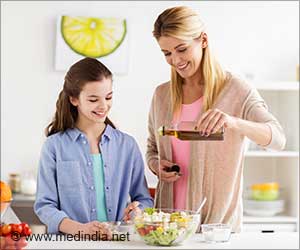Researchers at the University of Maryland have announced initial data that shows school-based intervention efforts help kids.
Researchers at the University of Maryland have announced initial data that shows school-based intervention efforts help kids buck a national trend by increasing their consumption of fruits and vegetables. To the researchers’ knowledge, these results are the first for Maryland, and on the leading edge nationally and internationally.
Dr. Bonnie Braun heads the team, which investigated the effects of school, family and community environments on the food-related behavior of elementary schoolchildren. Braun is an associate professor in Department of Family Science at the university’s School of Public Health and holds an appointment with the University of Maryland Cooperative Extension (MCE), part of the College of Agriculture & Natural Resources (AGNR).The research is part of a series of studies under Project FRESH, a school-based nutrition education program designed to increase fruit and vegetable consumption—especially of products grown by Maryland-producers - among elementary school children. The project is conducted by the University of Maryland Cooperative Extension Food Stamp Nutrition Education program, with MCE educators providing the curriculum and teacher education. Funding is provided by AGNR, the Maryland Department of Human Resources and the U.S. Department of Agriculture.
“Fruits and vegetables are a key contributor to children’s health,” says Braun. “Unfortunately, national reports indicate that children’s consumption of these foods normally decreases from kindergarten to fifth grade. Students from low-income families are particularly at risk of inadequate intake.” Many of these children are dependent on food served by the school for one-third to two-thirds of their daily food intake. However, even if schools increase fruits and vegetables on their cafeteria lines, children must be willing to eat them.
That’s why Braun and her team focused their research on schools where 50 percent or more of the students are eligible for free or reduced-price meals. They investigated the relationship between exposure to fruits and vegetables, taste preference and actual consumption among three groups of fourth-grade students in the Baltimore-Washington Metro area. “Our hypothesis was that school-based interventions, focused on increasing children’s preference for fruits and vegetables, would be associated with an increase in consumption both in school and at home,” says Braun.
The three types of interventions involved teacher training with a tested curriculum and parent events, teacher’s use of the curriculum without events involving parents, and an Extension educator teaching in student classrooms. All three approaches produced similar results, which supported the researchers’ hypothesis. They found that repeated exposure - through taste testing - to fruits and vegetables matters, and that even moderate interventions, focused on repeated tasting, make a difference.
Prior to the interventions, more than nine out of ten students (93 percent) were not eating the recommended five fruits and vegetables a day; seven out of ten (70 percent) ate fewer than three servings of fruits and vegetables daily; and of those, more than half (56 percent) ate fewer than two servings.
Advertisement
In a complementary effort, Dr. Josué López, MCE urban agriculture educator in Baltimore City, is working with Extension’s Expanded Food and Nutrition Education Program (EFNEP) and 4-H to conduct education programs related to vegetable gardening for city youth. Some of these programs involve the creation of vegetable gardens and the construction and maintenance of “salad tables” (large table-like containers on which lettuce and other vegetables can be grown) at schools and community centers. The salad table work stemmed from last year’s “Leveraging Extension” mini-grant program. As they cultivate their gardens, youngsters develop an appreciation for produce.
Advertisement
“This is a comprehensive initiative that will benefit schoolchildren by providing them with fresh, healthy fruits and vegetables while at the same time supporting a profitable, sustainable agricultural industry in Maryland,” says Dr. Bob Tjaden, MCE assistant director for agriculture and natural resources programs.
Source-Newswise
MED/SK














